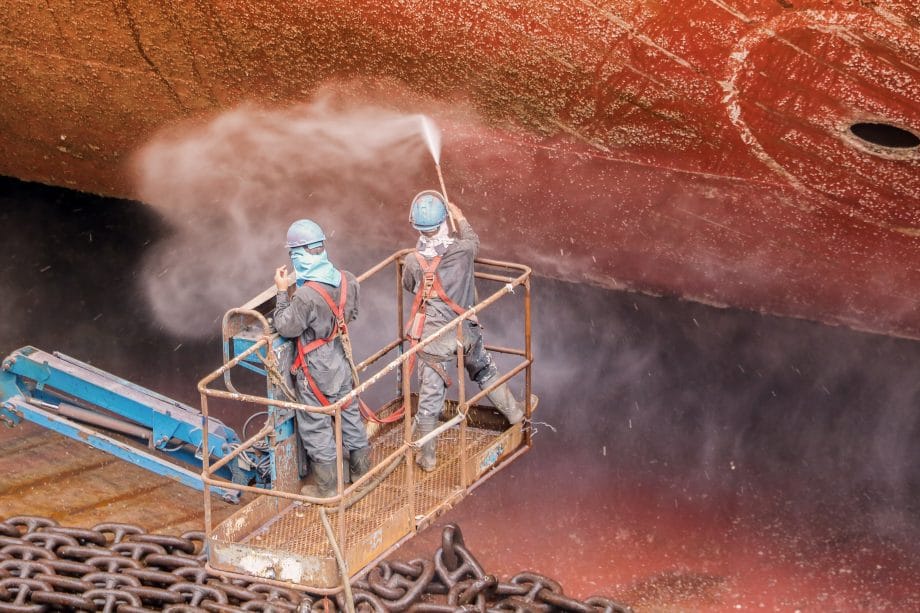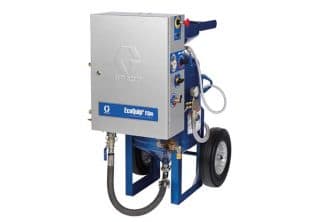A number of changes in the industry have led to the development of new abrasive blasting tools and methods, driving the widespread acceptance of vapour and wet abrasive blasting to replace dry blasting for surface preparation and cleaning.

New Rules Aim to Reduce Silica Dust
A new ruling that went into effect last year is aimed specifically at crystalline silica, which is used as an abrasive material.
This rule defines a permissible exposure limit (PEL) for respirable crystalline silica that is 50% lower for general industry and maritime. It is also 80% lower for the construction industry than the previous limits.
Crystalline silica is hazardous due to its physical structure. The silica has sharp points, and when inhaled can become lodged in the lungs. This can lead to increased risks of lung cancer, silicosis and various non-malignant respiratory diseases.
The rule is forcing the abrasive blasting industry to explore new methods that reduce their worker’s exposure to abrasive dust. A promising trend is a movement towards wet abrasive blasting (also known as vapor abrasive blasting) as an alternative to dry abrasive blasting.
Dry Abrasive Blasting (Air Blasting)
Dry abrasive blasting is a surface cleaning and surface preparation technique where loose abrasive media (e.g., silica sand) and compressed air are propelled against a work surface.
This process has a wide range of applications in surface preparation, including:
- Rust, scale and mould removal
- Anchor pattern creation prior to bonding or coating
- Cosmetic finishing and coating
- Contaminant removal
Dry abrasive blasting uses an air compressor’s energy to deliver an air/media mixture at high velocity and volumes to impact the surface or parts being processed. A pressure regulator is used to control the air delivery of the air compressor.
The downside to dry blasting is a lot of dust is created when the abrasive media strikes the substrate’s surface and breaks into finer pieces. Due to this, job sites require a containment facility or tenting to prevent the dust from escaping the worksite and going into public or residential areas. While this makes clean up easier, it also reduces the worker’s visibility to the surface being blasted.
The worst effects from dry abrasive blasting are the human health hazards associated with the large quantities of dust if inhaled by an operator not wearing the correct personal protective equipment (PPE). If dust escapes containment into a public area, the public and other workers could also be exposed to the dust. This makes compliance with the silica rule increasingly difficult if using dry blasting methods.
The Benefits of Shifting Towards Wet Abrasive Blasting Technology
Wet abrasive blasting uses a similar technique to dry blasting, but moisture is added to the blast media during blasting. The water tends to encapsulate the fine particles that are produced when the abrasive shatters upon striking the surface, so the particles are less likely to disperse into the air. This provides an advantage over dry blasting because the amount of dust that tends to bounce off the surface is reduced, resulting in a work space that’s easier to contain and clean up.
There are four wet abrasive blasting methods, each with their own advantages and disadvantages, designed to accomplish the same goal of less dust during surface preparation.
Water injection nozzles and halo nozzles
With abrasive air blasting, the abrasive is accelerated by the air from an air compressor through a hose and then delivered from the nozzle. A system with a water injection nozzle (WIN) has another hose and nozzle running parallel to the blasting hose and nozzle (think of a double-barreled shotgun) that squirts water alongside the abrasive media. A halo nozzle takes the concept one-step further by enclosing the abrasive blast in a ring of water around the blasting medium. These methods are relatively inexpensive and suppress 50-80% of the dust, but they consume large quantities of water.
Cabinets and blast rooms
In this alternative approach, the water and abrasives are mixed and sprayed inside a containment enclosure. This method has the advantage that you can reuse or recover the abrasive. However, the items to be blast are limited to the size of the enclosure.
Wet abrasive blasters
The abrasive and water is stored in an air pressurized supply tank. The mixture is drawn into the hose using the Venturi effect. While this method suppresses dust, it is difficult to precisely control the abrasive flow. It consumes large amounts of water and abrasive.
Vapour abrasive blasters
With vapour abrasive blasters the abrasive material and water are stored in a supply tank under water pressure. The mixture is then precisely metered into the airflow from the air compressor. These systems are very effective at dust suppression (up to 95% over dry blasting). They provide fine control over both the air pressure and the water/abrasive mixture.
The fine control permits the blasting of a wider range of surfaces including steel, aluminum, concrete, wood, and softer materials. This reduces the amount of water and abrasive media needed to prepare a surface. Less mixture means less toxic run off, thus saving on clean up and disposal costs. This is an important consideration for maritime applications (either in dry dock or when sailing). In these situations you cannot allow run-off to spill into the water.
Promain’s Vapour Wet Abrasive Blasting Equipment
If you are looking to expand your business to include wet abrasive blasting as an option to your clientèle, Promain would like to introduce Graco’s EcoQuip EQ2m.

Graco’s EcoQuip EQ2m can be used for concrete repair, coating removal, steel surface preparation and graffiti
removal. The versatility of the Graco EcoQuip 2 range is one of the characteristics that makes this equipment so remarkable. The best part is how easy it is to switch from one application to another. Graco EcoQuip 2 is designed to accept any media heavier than water and has a blast rating of up to 12 bar (175 PSI).
With Graco EcoQuip 2, contractors are no longer limited to just one or two types of jobs. Instead of focusing solely on steel surface preparation, that same contractor could now expand their business. They could now go into the concrete repair or restoration market using the same equipment.
Would you like to introduce this tool to your portfolio? Or would like a demonstration? Contact our technical team on 01462 421333. Ensure your paint and coatings projects are a success with Promain.co.uk.
Conclusion
Concern for worker safety and the environment, along with new regulations has led to the development of new abrasive blasting tools and methods. Due to technological innovations, the industry now adopts wet abrasive blasting technologies. This replaces dry blasting for surface preparation and cleaning operations.
Interested in finding out more about dry and wet abrasive blasting? Contact our technical team on 01462 421333 for more info. To see our products that require preparation via these techniques click below:
Metal Paints and Primers | Floor Paints and Coatings | Wall Paints and Coatings

